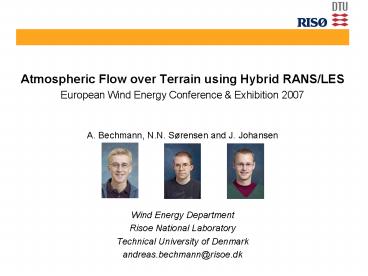Atmospheric Flow over Terrain using Hybrid RANSLES - PowerPoint PPT Presentation
1 / 21
Title: Atmospheric Flow over Terrain using Hybrid RANSLES
1
- Atmospheric Flow over Terrain using Hybrid
RANS/LES - European Wind Energy Conference Exhibition 2007
- A. Bechmann, N.N. Sørensen and J. Johansen
- Wind Energy Department
- Risoe National Laboratory
- Technical University of Denmark
- andreas.bechmann_at_risoe.dk
2
- Appetizer
- Simulation of Wind over Complex Terrain
3
Outline
- Introduction Terrain flow using CFD
- New approach Hybrid RANS/LES model
- Simulation results Askervein Hill
- Conclusions
4
Introduction Complex terrain?
5
Introduction Why CFD?
- Structural loads in complex terrain - most
important issue
- The critiquel wind happens locally - difficult to
measure
- Computational fluid dynamics (CFD) -provides
supplemant
6
Introduction EllipSys3D code
- Risø/DTU code, Applications
- Terrain computation
- Airfoil computations
- Rotor computations
- EllipSys3D code
- Incompressible Navier-Stokes
- Finite-volume (non-staggered)
- Pressure/Velocity formulation
- Patched multi-block grids
- Parallellized using MPI for distributed computers
7
Introduction problem formulation
- RANS-method
- Provides the mean wind speed and turbulence
intensity - Average amount of modelling
- Wall-func. easily implemented
- Computational affordable
- Complex terrain
- Wall-functions are needed due to surface
roughness (buildings, grass, trees etc.) - Simple flow models for complex terrain are
unreliable. - The unsteady wind is important when predicting
wind loads
- LES-method
- Provides detailed and transient wind information
- Minimum of modelling needed
- Wall-functions are problematic
- Near-surface flow is computational very expensive
8
Outline
- Introduction Terrain flow using CFD
- New approach Hybrid RANS/LES model
- Simulation results Askervein Hill
- Conclusions
9
New approach basic equations
- Stress term replaces viscosity term (high Re)
- RANS- and LES-equations written in same form
- different only by how stress term is modelled
10
New approach turbulence model
Similar to Detached-Eddy Simulation Spalart et
al. (1997)
11
New approach turbulent lengthscale
12
New approach turbulent lengthscale
13
Outline
- Introduction Terrain flow using CFD
- New approach Hybrid RANS/LES model
- Simulation results Askervein Hill
- Conclusions
14
Askervein hill background
- Askervein hill
- Hebrides, Scotland. 1982-1983
- H116m, planform 2x1km
- Computational grid
- N288x240x96 (7mill cells)
- Domain size 8.8x5.5x1.5 km
- Resolution ?23m, z10.03m
15
Askervein hill precursor
- Precursor
- Wind over flat-terrain with homogeneous roughness
- Simulation is run until statistics are converged
- Velocity slice are stored at each timestep
- Successor
- Wind over terrain with in- homogeneous roughness
- Variables are read at each timestep
- At least one flow through time before results are
sampled
16
Askervein hill flow field
17
Askervein hill speed-up
18
Askervein hill turbulence
19
Outline
- Introduction Terrain flow using CFD
- New approach Hybrid RANS/LES model
- Simulation results Askervein Hill
- Conclusions
20
Conclusions
21
- Thank you for listening!































